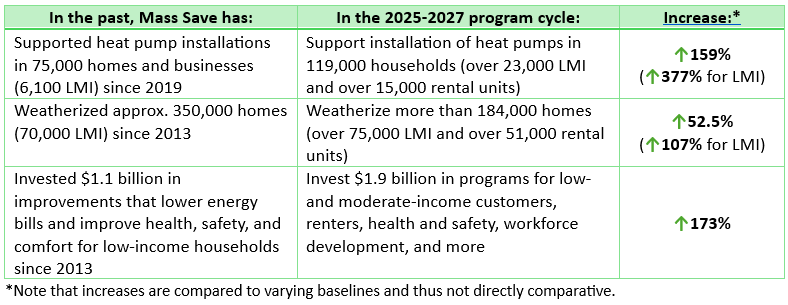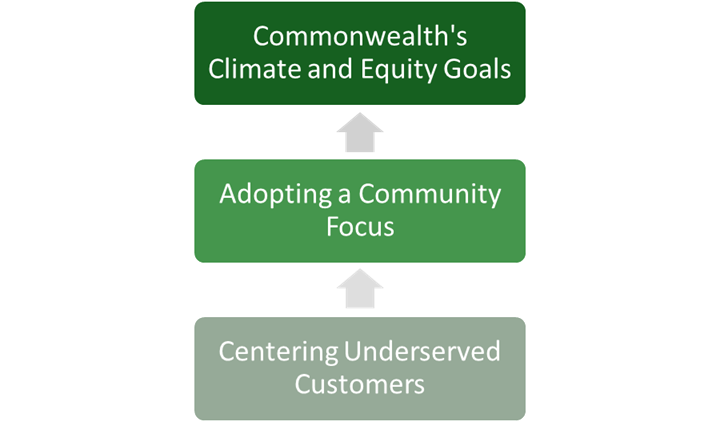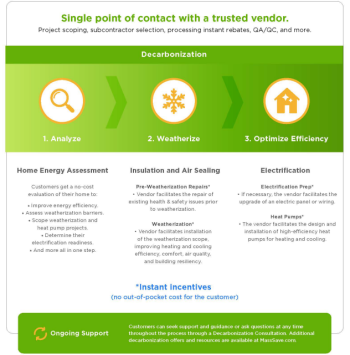

By Luke Miller | Mon, March 31, 25
On February 28, the Massachusetts Department of Public Utilities (DPU) approved the Mass Save 2025-2027 Energy Efficiency and Decarbonization Plan. These programs are designed to meet both energy savings goals and greenhouse gas (GHG) emission goals. This new plan aims to reduce 625,000 metrics tons (MT) of CO2 from electricity and delivered fuels savings and 375,000 MT from gas savings, as set by the Secretary of Energy and Environmental Affairs. Combined, these emissions savings goals are 18.3% stronger than the last three-year plan and will contribute to the state’s goal of reducing GHG emissions by 50% by 2030 (from 1990 levels).
This plan highlights Massachusetts’ continued leadership in energy efficiency as the program administrators (PAs) have set strong goals for weatherization projects and heat pump installations. The Massachusetts Energy Efficiency Advisory Council (EEAC) made significant contributions by recommending changes to invest more in reaching customers that previous Mass Save plans had not sufficiently served, including low- and moderate-income households and renters.
These goals, as shown in the table below, increase the number of projects undertaken by the state over the past several years. Collectively, the goals represent long-term savings that will promote energy affordability now and in the future. However, in its approval of the plan, the DPU reduced the three-year budget by $500 million and the program administrators are expected to re-file the plans reflecting the lower budget by April 30. The adjustments may lower some combination of the savings goals and program participation shown below.
This blog will highlight three key themes of the 2025-2027 Plan: innovative electrification initiatives, significant improvements to reaching low-income customers and renters, and improvements to customer experience and ease of access to Mass Save programs. Note that the descriptions here do not consider potential changes in response to the budget cut.
Innovative Statewide Electrification Programs
In the 2025-2027 Plan, the Mass Save PAs have designed a new way to deploy programs across both gas and electric utilities. Together, gas and electric PAs will offer electrification programs in both the residential and commercial sectors under a statewide “Mass Save Electrification” umbrella. This innovative program was designed in response to the removal of fossil fuel incentives required in the 2022 Act Driving Clean Energy and Offshore Wind.
Through the Mass Save Electrification program, any customer served by a gas or electric utility can receive a heat pump rebate. This program introduces a single touchpoint for customers, reducing confusion and streamlining participation. To implement a statewide program across utility territories, PAs have agreed to proportionally allocate costs and savings on a project basis. Previously, savings were allocated across both programs and providers to encourage coordination and cooperation. In Vermont, Green Mountain Power and Efficiency Vermont, the statewide energy efficiency utility, use a similar attribution method to allocate savings from its jointly funded heat pump rebate program.
The PAs are also funding electrification through the federal Inflation Reduction Act (IRA) Home Energy Rebates. The Massachusetts Department of Energy Resources (DOER) has authorized PAs to oversee implementation of nearly $72 million of the Home Energy and Appliance Rebates (HEAR) program funds to assist low- and moderate-income customers with efficiency upgrades like electrical panel and wiring upgrades and electrification of space and water heating.
Integrating new federally funded programs within the existing structure of PA programs allows utility PAs to claim energy savings generated from these joint projects and to deliver new funds in a more efficient way. This method, full attribution of savings to utility implementers, is one of the options explained in NEEP’s report, Expanding The Energy Savings Pie: Attribution Frameworks to Align IRA Home Energy Rebates and State Programs.
For future electrification efforts, PAs could consider using energy data to complete targeted electrification projects. Leveraging Mass Save’s existing data reporting system, PAs could identify neighborhoods where it would be cost-effective for ratepayers to move a group of customers off the gas system to all-electric alternatives.
Emphasis on Reaching Income-Eligible Customers and Renters
Energy insecurity is especially pronounced in New England, which has the largest gap between low- and median-income energy burdens coupled with some of the highest energy costs in the country. To address this, PAs will promote broader program access, particularly for renters and low- to moderate-income (LMI) residents. The plan contains $1.3 billion in incentives for LMI customers, which represents one-third of the budget.
Nearly half of the budget for LMI incentives ($616 million) is for renters. PAs aim to accomplish ambitious segment-specific goals, including weatherizing over 51,000 rental units and installing heat pumps in more than 15,000 rental units. For the first time, qualified renters will be able to access moderate-income program offerings, which have historically been available just to homeowners. Renters living in “Designated Equity Communities” (DECs) will automatically qualify for no-cost weatherization, barrier remediation, and electrification services that do not increase energy burdens through the multifamily Residential Turnkey Program (discussed below). PAs also plan to create a dedicated Mass Save Renters webpage and resources that will assist renters in discussing upgrades with their landlords.
The plan also includes programs focused on community-based needs and outreach. PAs have designated 21 cities and towns as DECs, which means they are composed of populations that are at least 50 percent LMI and at least 35 percent renters. Additionally, landlords in DECs must commit to not raising rent or evicting tenants for a period following the receipt of program incentives, ensuring housing security for renters. The plan expands the existing Community First Partners (CFP) program by increasing funding for partner organizations by $25,500 annually, increasing data sharing, improving training for CFP Energy Advocates to promote energy efficiency initiatives, and improving marketing and flexibility in conducting community-specific outreach.
Massachusetts’ Bottom-up Approach to Decarbonization Through an Equity Lens
Adapted from “Figure 1: A Bottom-up Approach to Decarbonization Through an Equity Lens,” Mass Save Plan p. 36
While the plan proposes promising programs to better serve LMI customers and renters, there is still room to improve future Mass Save programs to better address these underserved populations. One way is by ensuring goals for spending and installation of technology are proportional to the population. The EEAC pushed for higher budgets in the 2025-2027 Plan for this customer segment, and while the PAs did allocate more funding, they fell short of the EEAC’s recommendations for LMI heat pump installations.
Improving and Simplifying the Customer Experience
Program complexity can be a barrier to deploying energy efficiency solutions. To address this, the PAs have devised a suite of improvements that will aim to facilitate a smoother process for both customers and contractors.
First, PAs are deploying the Residential Turnkey Solutions Program, an innovative home upgrade hub that will provide incentives, financing, and technical assistance to help residents make affordable improvements to their homes. The program will address these barriers by coordinating weatherization, barrier mitigation, and electrification upgrade projects through a single touchpoint, reducing administrative and financial burdens for participants. This program will first be available to customers in DECs and other LMI customers. It will eventually expand to all customers near the end of the cycle.
The PAs have also simplified and expanded income qualification for LMI customers. PAs will consider both state median income (SMI) and area median income (AMI), recognizing the higher of the two as the upper boundary to qualify for moderate-income status. PAs will also expand automatic qualification for income-qualified programs to customers enrolled in other state programs that use similar income qualification metrics. Moderate-income customers will be able to self-attest to their income levels and family size when applying for no-cost weatherization services through the Turnkey program.
Finally, PAs are announcing a new statewide, multilingual customer support center for residential and small business customers.
This program will provide comprehensive support on all energy efficiency and electrification offerings in the state, including those from Mass Save, loans through HEAT and the Climate Bank, decarbonization consultations, and relevant tax credits or federal incentives. There will be an additional dedicated client services center for low-income customers, and commercial customers will see improvements in technical assistance offerings, including standardization of the support offered.
One additional element that could benefit future program delivery would be tracking and reporting of customer attrition in all programs. Tracking customer drop-out would allow PAs to investigate unforeseen barriers and implementation issues which would allow for targeted improvements in future programs.
The Future of Energy Efficiency in Massachusetts
Mass Save has a history of promoting energy affordability in Massachusetts. The program lowers overall energy consumption, promotes advanced technologies, provides targeted incentives and assistance to specific groups of customers, improves grid efficiency to limit costs, and promotes prudent long-term utility investments. A recent Synapse study showed that that energy usage in New England would be nearly 13 percent higher without the intervention of energy efficiency programs. Massachusetts is a national leader in energy efficiency, garnering widespread recognition and recently ranking second in the national ACEEE 2025 State Scorecard. The 2025-2027 Plan is forecasted to deliver more than $2.76 in benefits for each dollar invested, and since 2013, Mass Save has delivered more than $31 billion in total customer benefits. Investments that deliver such significant net benefits to Massachusetts residents and businesses alike should not be subjected to budget cuts. With a lack of certainty at the federal level, we need exemplary states like Massachusetts now more than ever to play a central role in establishing durable approaches to promote efficiency, affordability, and public benefits.



